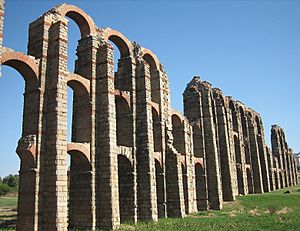Acueducto de los Milagros facts for kids
|
Acueducto de los Milagros
|
|

Aqueduct bridge
|
|
| Location | Mérida (Badajoz), Spain |
|---|---|
| Coordinates | 38°55′28″N 6°20′48″W / 38.92444°N 6.34667°W |
| Type | Roman aqueduct |
| History | |
| Material | Granite and red brick |
| Official name: Los Milagros Aqueduct | |
| Type: | Cultural |
| Criteria: | iii, iv |
| Designated: | 1993 (17th session) |
| Part of: | Archaeological Ensemble of Mérida |
| Reference #: | 664-001 |
| Region: | Europe and North America |
| Area: | 0.1177 ha (0.291 acres) |
| Buffer zone: | 20.9 ha (52 acres) |
| Official name: Acueducto Romano "los Milagros" | |
| Type: | Non-movable |
| Criteria: | Monument |
| Designated: | 13 December 1912 |
| Reference #: | RI-51-0000112 |
The Acueducto de los Milagros (which means "Aqueduct of the Miracles" in English) is an ancient Roman aqueduct. You can find it in Mérida, a city in Spain.
The Romans built this amazing structure around the 1st century AD. Its main job was to bring fresh water from the Proserpina Dam. This water was for the ancient Roman city called Emerita Augusta, which is now Mérida.
After the Roman Empire ended, the aqueduct slowly fell apart. Today, only a part of it still stands. This remaining section is a powerful reminder of Roman engineering. In 1993, the Aqueduct of the Miracles became a UNESCO World Heritage Site. It is part of the larger Archaeological Ensemble of Mérida.
What is the Aqueduct of the Miracles?
Only a small part of this huge aqueduct is still standing. It has 38 tall, arched pillars. These pillars reach about 25 meters (82 feet) high. They stretch for about 830 meters (2,723 feet).
The aqueduct was built using a special Roman technique. It used a mix of materials called opus mixtum. This means it has strong granite blocks mixed with red bricks. The structure has two rows of arches, one on top of the other.
This impressive structure originally carried water to the city. The water came from a reservoir called the Proserpina Dam. A stream named Las Pardillas fed this dam. The dam was about 5 kilometers (3 miles) northwest of Mérida.
When was the Aqueduct of the Miracles built?
Experts believe the aqueduct was first built in the 1st century AD. There might have been some repairs or new building work around 300 AD.
Later, people living in Mérida were so amazed by the aqueduct. They thought it was so incredible that they called it the "Aqueduct of the Miracles." This name shows how much they admired its strength and beauty.
The Aqueduct of the Miracles was one of three aqueducts built in Mérida. Another one was the Aqua Augusta, which was about 15 kilometers (9 miles) long. It got its water from the Cornalvo reservoir. The third was the San Lázaro, which used underground channels.
Today, the Aqueduct of the Miracles is protected. It is part of the Archaeological Ensemble of Mérida. This whole area is a UNESCO World Heritage Site. Nearby, there is also a small Roman bridge. It is called Puente de Albarregas. It runs right next to the aqueduct's arches.
See also
 In Spanish: Acueducto de los Milagros para niños
In Spanish: Acueducto de los Milagros para niños
- List of aqueducts in the Roman Empire
- List of Roman aqueducts by date
- Ancient Roman technology
- Roman engineering

